This article was republished with permission from WTOP’s news partners at Maryland Matters. Sign up for Maryland Matters’ free email subscription today.
This content was republished with permission from WTOP’s news partners at Maryland Matters. Sign up for Maryland Matters’ free email subscription today.
All 24 public school systems in Maryland have begun summer programs to help students catch up from learning loss induced by the coronavirus pandemic, but State Superintendent Mohammed Choudhury said that it is also critical to understand learning gaps that existed before the pandemic — and to advance beyond that.
“It’s been the mantra right now nationally: we’ve got to recover, go back to normal, we’ve got to accelerate,’” Choudhury said Tuesday during his first State Board of Education meeting since starting in the superintendent position earlier this month. “One of the important things is to remind ourselves of what pre-pandemic days looked like in terms of progress, in terms of our baselines.”
Choudhury presented data on student learning progression prior to the pandemic to help understand what the state can expect in the upcoming school year.
Historically in Maryland, fewer than 20% of students who performed below grade level reached proficiency within two years in Maryland public schools, Choudhury said.
And even positive results can be tempered. For example, 18% of students who scored below proficiency on their third grade English tests were proficient by fifth grade. And 17% of third-graders who were on track lost proficiency by the time they got to fifth grade.
The same trends were seen in math tests and for students in kindergarten and first grade, according to Choudhury.
“The point is — what are we recovering to?” Choudhury said. “In terms of recovering, normal wasn’t good enough because we know if you’re not proficient in third grade, it becomes ridiculously harder to close that gap.”
But “the resources are there,” Choudhury continued. “Not only do [we] have federal funding, but [we] also have state funding commitment, so we can’t get this wrong. I mean, this is really a moment to get it right.”
The Blueprint for Maryland’s Future, a sweeping education reform bill, became law this year and commits state funding for education for the next decade.
Education advocates lauded Choudhury’s use of data.
“I hope that there are more instances like that at future board meetings where we actually get to dive into some of that specifically disaggregated data and compare what data says to the questions that we actually have,” said Shamoyia Gardiner of Strong Schools Maryland. “I hope that speaks to a much more data-driven MSDE.”
A supplemental bill to the Blueprint for Maryland’s Future that passed the General Assembly this year requires all local school systems to implement tutoring and summer school programs in response to the disrupted learning from the coronavirus.
There are more than 123 summer programs across all local school systems and all are offering support in mathematics and English, Carol Williamson, deputy state superintendent, told the state board. Around 140,000 students are participating in summer programs, according to Choudhury.
Lori Morrow, the parent representative to the board, asked if there were some school systems that could not meet the demand for summer programs, perhaps due to teacher or staff shortages, and if there were student wait lists.
Williamson said that no school system included such a comment in their explanations of their summer programs, but that she would check on that answer.
In addition, the state board will submit its plan on how it will use its American Rescue Plan’s Elementary and Secondary School Emergency Relief (ESSER) funding to the U.S. Department of Education on Friday, which means the state can receive the remaining one third of its ESSER funding by August.
In April, states received two-thirds of their ESSER funds. The remaining third will become available after the U.S. Department of Education approves the state’s plan for using the funds.
MSDE must grant local schools systems at least 90% of that funding. The state prioritized in-person instruction, and addressing social-emotional learning and academic losses from the pandemic in its final ESSER plan.
But MSDE cannot mandate how local school systems use those funds, and local schools can also use these federal funds to focus on improving school buildings and to upgrade air ventilation, Choudhury said.







